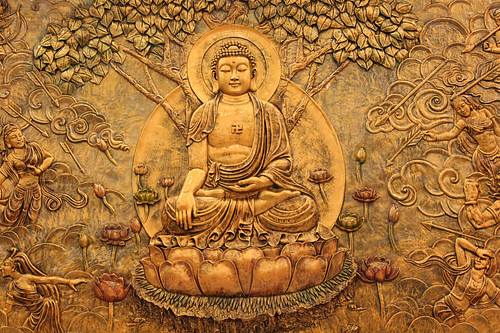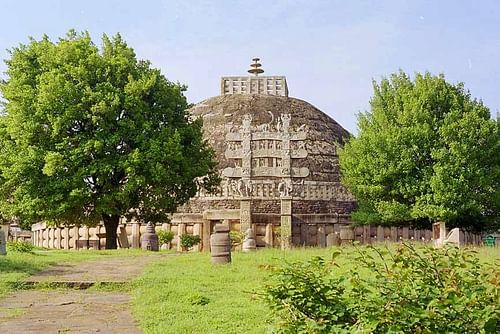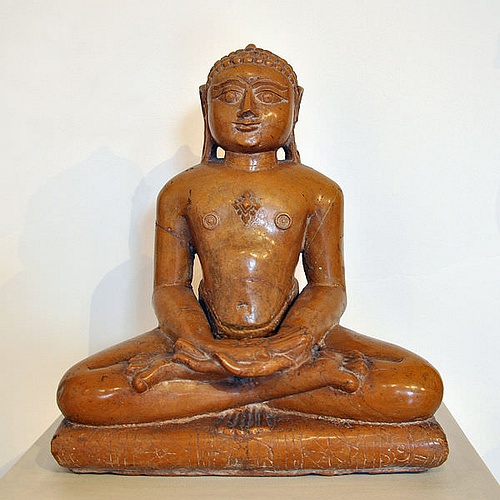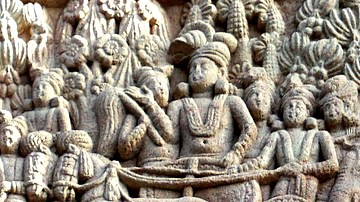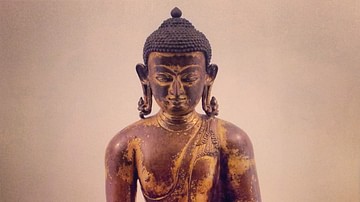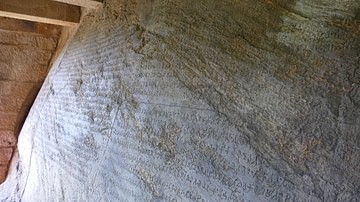The dates of the Buddha, Siddhartha Gautama, have been a concern of, primarily, Western scholars for well over 100 years now owing to the particularly Western need for precise dating of historical persons and events. The problem with precise dating of the Buddha's life is that it is simply not possible due to a lack of supporting primary sources.
This is not to exclude modern-day Eastern scholars who strive for the same nor to denigrate efforts at precision in historical dating, but ancient historians did not have the same need for exact dates that modern-day scholars obsess over and so, as Buddhist scholarship amply proves, efforts at arriving at set dates are bound to be frustrating and ultimately futile; though this has not stopped anyone from the attempt.
The dates of the Buddha have been derived from various chronologies which all recognize that Siddhartha Gautama lived for 80 years but disagree on the dates those 80 years encompass. The chronologies are:
- Ceylonese Long Chronology: c. 624 - c. 544 BCE
- Corrected Long Chronology: c. 567 - c. 487 BCE
- Indian Short Chronology: c. 448 - c. 368 BCE
- Modern Chronology: c. 563 - c. 483 BCE
There is also the so-called Dotted Chronology which attempts to date Buddha's death through reference to the Five Patriarchs who came after him, their successors, and a dot placed by them in manuscripts at the end of their lives. Scholars generally reject this chronology due to the impossibly long dates attributed to the patriarchs and the fact that not every Buddhist school recognizes the same patriarchs and dates. The other chronologies have similar problems, and even the modern attempt can only be an approximation.
Foundation Legend
The difficulty in ascertaining the dates of the Buddha is the legend that tells the story of Siddhartha's early life, enlightenment, and post-enlightenment activities. Scholars agree that he existed but also agree that there is no way of knowing whether the events of his life as depicted reflect historical truth.
According to the legend, Siddhartha was born to a Hindu king who, in response to a prophecy which claimed the child would become a great king or spiritual leader, protected his son from any form of suffering for the first 29 years of his life. The reasoning seems to be that, as long as Siddhartha was unaware of the unpleasant aspects of existence, he would feel no need to embrace a spiritual path.
The king's plan worked well until Siddhartha, out for a ride in his coach (or chariot) was taken on an unfamiliar route by his driver. According to some versions of the legend, his regular driver was sick that day and the king had prohibited any sick or injured, old or lame individuals from interacting with his son, and the replacement driver was somehow unaware that he should keep the prince within the confines of the pleasure gardens. In other versions, no reason is given for the driver to have taken Siddhartha out of the idyllic compound and into the streets of the city.
For whatever reason, Siddhartha was exposed to the real world and saw the pivotal Four Signs – an aged man, a sick man, a dead man, and a spiritual ascetic. He understood then that he was as susceptible to sickness, age, and death as anyone else, recognized that the life of pleasure he had been living could end at any time, and so renounced his position to follow the example of the ascetic, the only person he encountered who seemed undisturbed by the nature of life. After years of spiritual discipline, he attained enlightenment while sitting beneath a Bodhi tree in the village of Bodh Gaya and became recognized as the Buddha (“awakened one”), after which he began to teach others the path toward enlightenment.
Teachings & Death
His spiritual illumination made clear to him that people suffered in life because they clung to impermanent situations, people, and objects as though they would last and, in doing so, resisted the natural flow of life, which was perpetual change. In order to escape from suffering, one had to let go of the insistence on permanent states of being and recognize that all was in constant flux, nothing would last, and nothing, therefore, had any lasting meaning.
One could leave suffering behind, he taught, by recognizing the Four Noble Truths which led one toward the mental and spiritual discipline of the Eightfold Path and, as one proceeded on this path, one would leave sense-attachment behind and achieve nirvana (literally a “blowing out” of cravings and attachment). As long as one resisted the nature of life, one was trapped in a never-ending cycle of rebirth and death (samsara) but, by following his path, one could attain liberation. He continued to teach until his death, at age 80 and, afterwards, his disciples continued his vision and established schools in his name.
The Origin of Foundational Legend
Many attempts have been made to positively identify Siddhartha's father and kingdom, and plenty of theories fill books around the world claiming to have done so. The problem with these theories is that they proceed from a legend which was written many years after Siddhartha's death and with a definite purpose. Scholars Robert E. Buswell, Jr. and Donald S. Lopez, Jr. comment:
Although there is great interest in the West in the “biography” of Gautama or Sakyamuni Buddha, the early tradition seemed intent on demonstrating his similarity to the buddhas of the past rather than his uniqueness. Such a concern was motivated in part by the need to demonstrate that what the Buddha taught was not the innovation of an individual, but rather the rediscovery of a timeless truth (what the Buddha himself called “an ancient path”) that had been discovered in precisely the same way, since time immemorial, by a person who undertook the same type of extended preparation. In this sense, the doctrine of the existence of past buddhas allowed the early Buddhist community to claim an authority similar to that of the Vedas of their Hindu rivals and of the Jaina tradition of previous tirthankaras. Thus, in their biographies, all of the buddhas of the past and future are portrayed as doing many of the same things. (149)
The foundational legend which has come to serve as the Buddha's biography was not written to establish a definitive chronology of his life but to serve as a teaching tool as well as to establish an ancient origin for the belief system. This being so, attempts to attach certain dates to the legend are as futile as any which treat myth as history.
The Chronology Problem
Buddha himself wrote nothing and no works concerning the events of his life appear until many years following his death. Exactly when that death (his nirvana, in Buddhist parlance) occurred, however, is the problem scholars have tried to resolve. Up until the 20th century CE, Buddha's dates were accepted as c. 624 - c. 544 BCE (the Ceylonese Long Chronology) which was then revised to c. 567 - c. 487 BCE based on the edicts of the Mauryan king Ashoka the Great (r. 268-232 BCE). These dates, however, differ significantly from the Short Chronology of Indian tradition which cites c. 448-368 BCE and was accepted based on the belief that Buddha died exactly 100 years before the coronation/consecration of Ashoka.
The Indian Chronology was agreed upon, seemingly, based on no more than a belief that Buddha died exactly 100 years before Ashoka's reign because it was a solid, round number which seems to have sounded right as the interval between the death of the founder of Buddhism and its greatest proponent, Ashoka, who would spread Buddhism to the rest of the world. This interval is impossible to define as 100 years, however, as it has to reference the chronology of the Five Patriarchs of Buddhism who lived between Buddha's death and Ashoka's reign and whose dates are given as extremely long, in keeping with the tradition of hagiographical texts of many different cultures.
The modern scholarly consensus for the dates of the Buddha, since c. 1906 CE, has been c. 563 - c. 483 BCE based on external evidence such as Jain texts, Ashoka's reign, and astronomical calculations as well as probable dates for the founding of Buddhist schools of thought. These dates, however, are also approximations and, even though they are more acceptable to the modern-day sensibilities concerning precise dating, are far from certain. No dates for the Buddha's birth, life events, or death will ever be certain because the first writers to set down the events of his life, as noted, did not care about precision in dating; they cared about telling a memorable story.
Dating in the Ancient World
A lack of specific dates in an ancient history or biography is hardly unique to the Buddhist tradition, however. Ancient historical texts, of any culture, tend to date events in relation to others which were better known. In Mesopotamia, for example, one might find an event recorded as “ten years after the king Shulgi, son of Ur-Nammu, made his great run” and an audience would know that the writer was referring to Shulgi of Ur (r. 2029-1982 BCE) and his famous one-day run between the cities of Nippur and Ur in order to officiate at the religious festivals in both cities. In Egypt, one finds the same paradigm with lines like, “Two years after the Great Inundation” or “In the fifth year of Ramesses' reign” and in India the same model was followed. There was no perceived need to write anything like, “Shulgi of Ur made his great run in 2022” because simply stating the famous event gave an audience context from which they could date, more or less, whatever less-famous event the author was addressing.
The point of any ancient historical text was not to give some later audience an exact timeline of events but to make sure later generations remembered that something had happened worth remembering. Indian literature adheres to this paradigm as closely as any other ancient civilization as it impresses upon an audience what happened but does not go far in stating when. An example of this is the Battle of Kurukshetra as it appears in the Mahabharata and Bhagavad Gita. Although modern-day scholars and adherents of Hinduism frequently cite approximate – or even definite - dates for the battle, the texts themselves have little concern for this. This same paradigm holds for the early texts on Buddhism which have been relied upon to establish Buddha's dates.
The Chronologies
The four chronologies most often referenced, as noted, were developed from texts written long after the Buddha lived and taught. The means employed by scholars to establish these timelines seem as arbitrary as the dates themselves and, at one point or another, all have been accepted as “authoritative”. The Ceylonese Long Chronology was in use up through the early 20th century CE (and is still recognized today by some schools of thought) only because it was based on two of the earliest Buddhist texts still extant.
Ceylonese Long Chronology: c. 624 - c. 544 BCE: The Long Chronology, from Sri Lanka, was held to be the most accurate based on two works, the Dipavamsa (3rd-4th centuries CE) and the Mahavamsa (5th century CE). Sri Lanka was the first nation visited by Buddhist monks when Ashoka began his missionary efforts and the first to fully embrace the belief system. The Dipavamsa claims that Buddha himself visited Sri Lanka three times in his life which is not corroborated by Indian or Chinese texts. The Mahavamsa drew on the earlier work to present the story with a tighter narrative form. Although historical figures do appear in the works, claims such as Buddha's visit cannot be substantiated, and the chronology was later revised to correspond to Ashoka's reign.
Corrected Long Chronology: c. 567 - c. 487 BCE: Using the Edicts of Ashoka as a basis, especially the 13th Major Rock Edict, this chronology includes reference to the Five Patriarchs and places the date of Ashoka's 13th Edict at 255 BCE, claiming a span of 232 years between Buddha's death and the edict which relates Ashoka's conversion to Buddhism after the Kalinga War and his efforts in spreading Buddhist thought. This timeline also includes the Five Patriarchs and their very long lives, which makes it difficult to accept as accurate.
Indian Short Chronology: c. 448 - c. 368 BCE: This chronology insists on a span of 100 years between Buddha's death and Ashoka's coronation. The number seems to have been arrived at arbitrarily.
Modern Chronology: c. 563 - c. 483 BCE: The Modern Chronology was first established between 1906-1909 CE and published in the Journal of the Royal Asiatics Society. The scholar John M. Senaveratne, writing shortly afterwards, comments:
When did Gautama Buddha die? The date hitherto advanced, and till a year or two ago, very generally accepted, was 544 B. C. But Dr. Fleet, the great Oriental scholar, has recently established that Buddha died, not in 544 B.C., but in 483 B. C., i.e., 61 years later than the date usually assigned to that event. The correctness of Dr. Fleet's date is beyond question. (141)
This chronology is based on the accepted 80 years as the length of Buddha's life and that he was a younger contemporary of Mahavira (also known as Vardhamana, l. c. 599-527 BCE) who established and codified Jainism. Dr. Fleet seems to have taken the c. 599 BCE date and established Siddhartha's birthdate as c. 563 BCE based on astronomical calculations, giving his death date as 80 years later, c. 483 BCE. Although these dates are generally accepted in the modern day, scholarly consensus is by no means universal. Scholar Heinz Bechert, for example, writing in 1980 CE, refers to Fleet's theory as a series of “extremely unreliable argumentations” (31). Even so, these are the dates most commonly accepted for the life of the Buddha.
The other chronology, usually rejected by scholars, is the so-called Dotted Chronology which comes from Chinese sources. This account is based on the claim that, after the Buddha died and his teachings were committed to writing, his lead disciple made a dot in the manuscript after the last passage he wrote. The Five Patriarchs, and their successors, all did the same just before their own nirvanas, with the last dot being placed in 489 CE, giving a death date for Buddha, based on the death of the last patriarch to make the dot, at 486 BCE.
Conclusion
The Buddha himself would not have cared about establishing a chronology for his life. There is nothing in his teachings which would suggest a concern for when he was born, how he lived – other than in how it reflected his vision – or when he died as this would represent attachment to the world. The fact that the schools which developed in his name have often been at odds with each other over the “right teaching” of their founder and the dates of his life represent the institutionalization of the belief system, not a reflection of the Buddha's original vision and message.
Attempts will no doubt continue to establish the authoritative dates of the Buddha, but it is unlikely they will be any more successful than those of the past. Whoever Siddhartha Gautama was, or when he lived, is not as important as what he taught and attempts at defining and holding to any given chronology seem to define what the 20th century CE poet T.S. Eliot suggested in the line from his Four Quartets, “We had the experience, but missed the meaning.” Buddha himself would no doubt have gently admonished those who insist on definitive dates and events in his life to let the subject go along with any other attachments to the illusion of permanence which, as he stressed, only tie one to a cycle of suffering.

